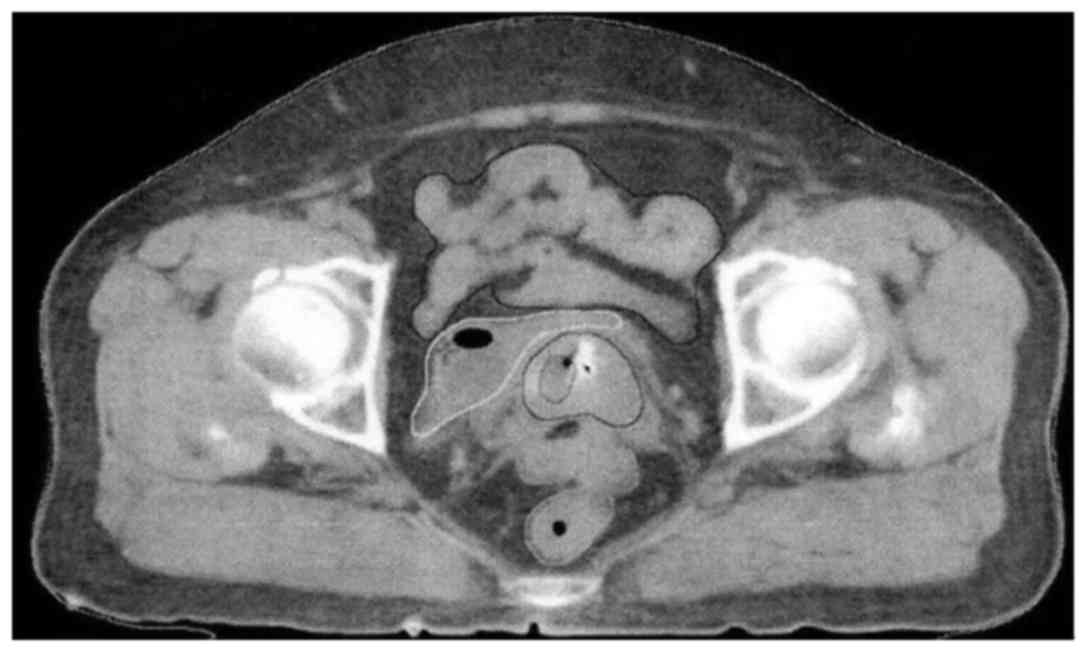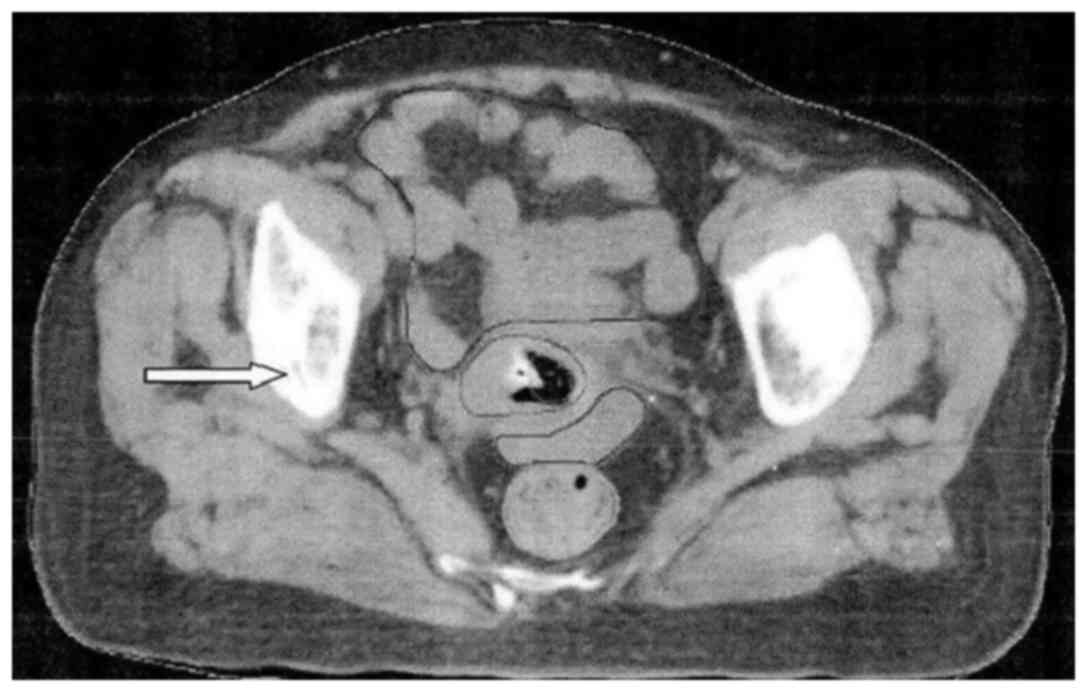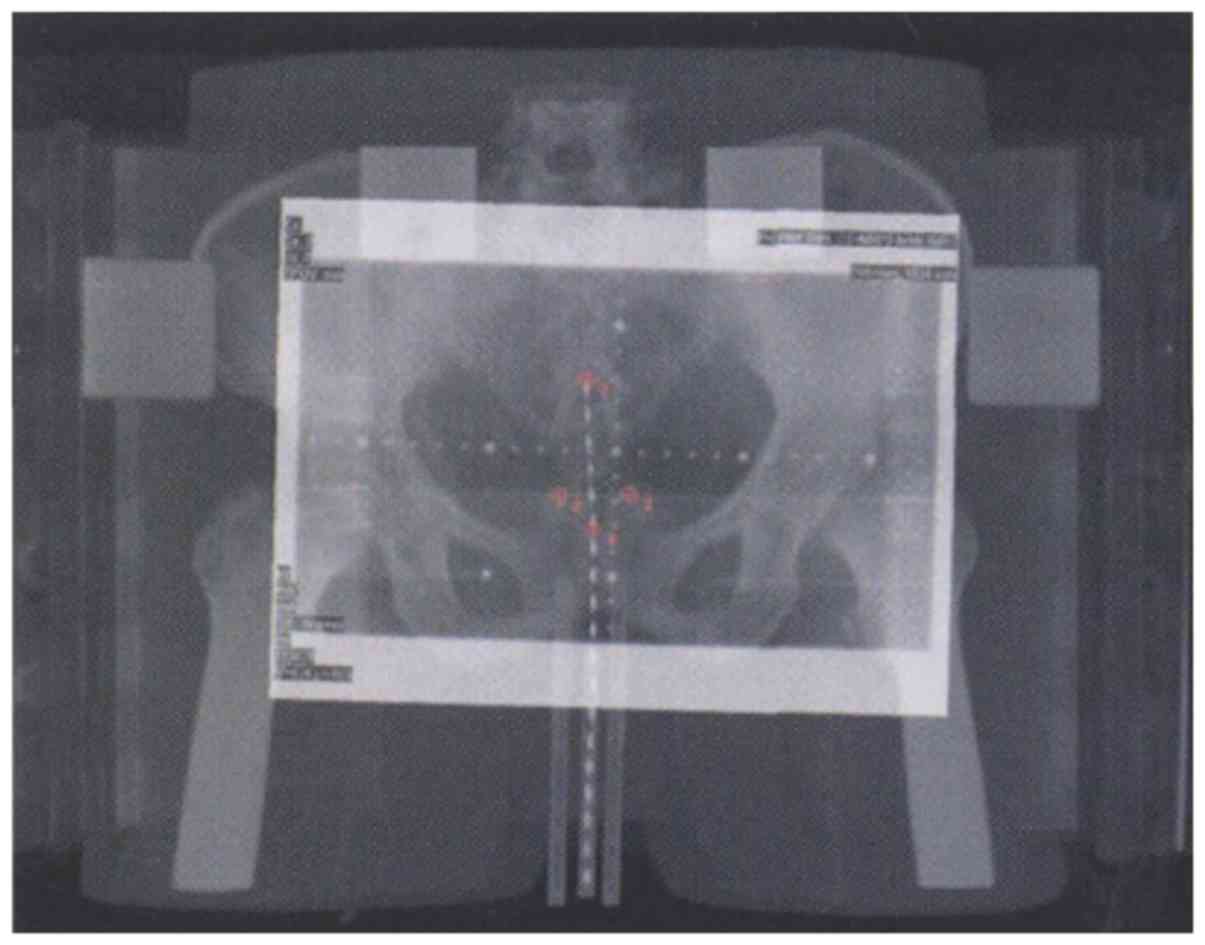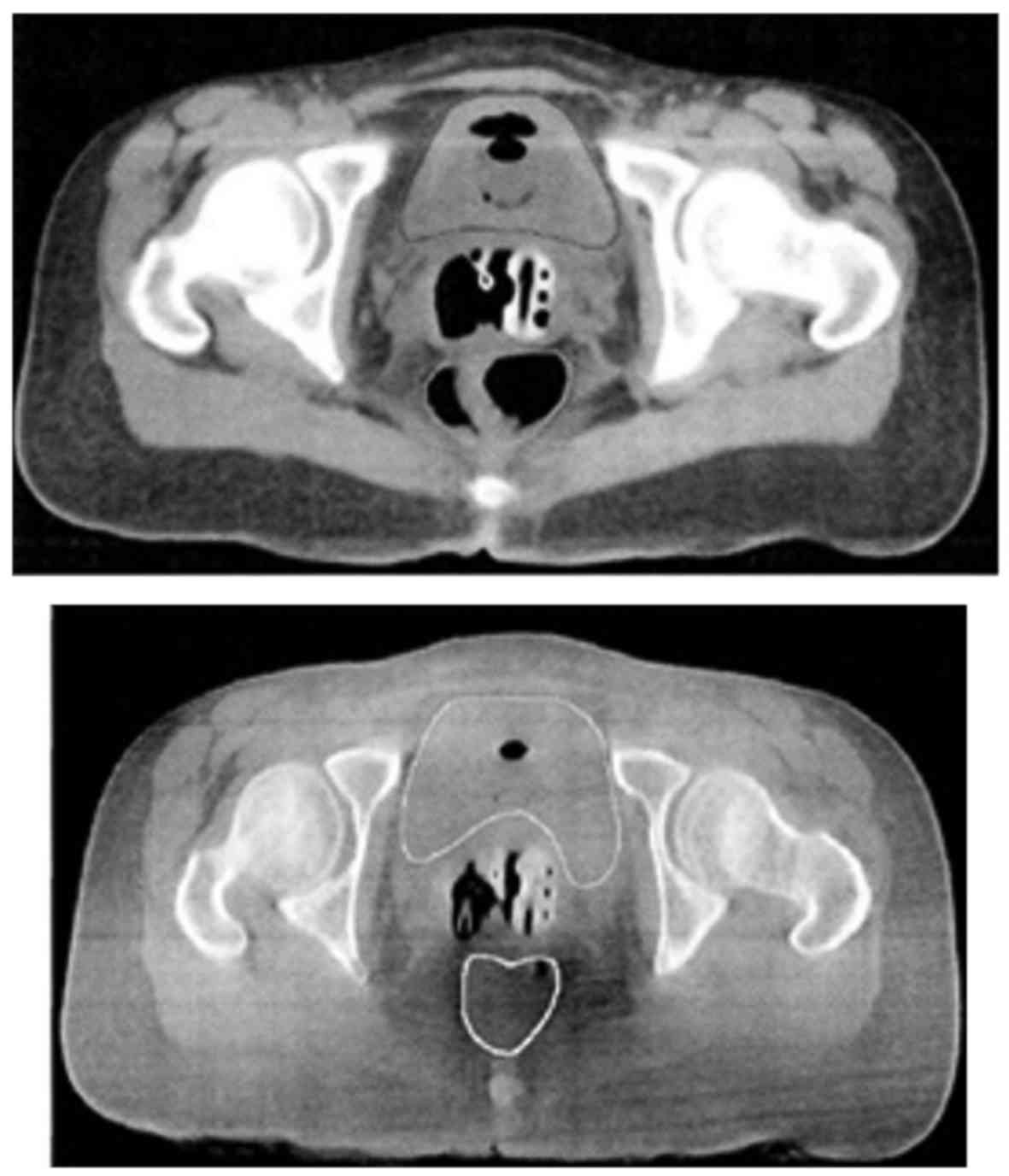Error analysis of applicator position for combined internal/external radiation therapy in cervical cancer
- Authors:
- Published online on: July 2, 2018 https://doi.org/10.3892/ol.2018.9061
- Pages: 3611-3613
-
Copyright: © Ying et al. This is an open access article distributed under the terms of Creative Commons Attribution License.
Abstract
Introduction
Cervical cancer is one of the most common malignant tumors in the modern gynecological clinical practice, which seriously affects the life and health of patients and their quality of life (1). Uterine cavity brachytherapy and intensity modulated radiation therapy (IMRT) is a basic clinical treatment for cervical cancer (2). In recent years, the application of modern image-guided technology has been widely used in brachytherapy of cervical cancer patients. However, during radiotherapy, the applicator position is prone to error. If the error is relatively large, the accuracy and effectiveness of the treatment are affected (3–5). Here, we discuss the error in applicator position in after-loading combined radiation therapy for cervical cancer for the first and second sessions to provide valuable reference to enhance the therapeutic effect of irradiation in patients with cervical cancer.
Materials and methods
Patient information
We recruited 22 cases of cervical cancer treated with radiotherapy in Sichuan Cancer Hospital and Institute (Chengdu, China) from November 2013 to January 2016. The patients were aged 25–72 years, with a mean age of 47.1±4.4 years. Clinical stages: IIb 7 cases, IIIa 9 cases, and IIIb 6 cases. Pathological type: 17 cases of phosphate cell carcinoma and 5 cases of adenocarcinoma. The study was approved by the Ethics Committee of Sichuan Cancer Hospital and Institute and written informed consents were signed by the patients and/or guardians.
Methods
Main instruments and equipment: GE64 spiral CT (CT-Sim), Nucletron Simulix-HP simulated locator, Varian Clinac 23EX linear accelerator, Oncentra MasterPlan 3.2 nucletron after-loading planning application system, and the Fletcher applicator.
Main treatments: The main links for the radiation therapy are the evacuation routes of rectal and bladder physiology, manufacture of vacuum pad and bulk film, and the installation place of the applicator. Normal saline (250 ml) was injected into the bladder of the patients. CT-Sim scan, regional delineation of target location for radiotherapy treatment (Figs. 1 and 2), scheme design and planning DRR image registration, intra cavity radiation therapy, electronic portal imaging technology (EPID) results, in vitro radiation therapy, EPID images, DRR images fusion (Fig. 3), and the statistics of error position of the applicator equipment. We also implemented image fusion processing, applicator position parameter calibration, and setup verification and other processing technology.
Statistical analysis
IBM SPSS 19.0 (Armonk, NY, USA) was used for all statistical analysis. Measurement data were expressed as mean ± SD. The comparison among multiple groups was performed using ANOVA and the post hoc was Dunnett's test. P<0.05 was considered to indicate a statistically significant difference.
Results
Comparison of the first and second CT-Sim fusion in the 22 patients in this cohort is shown in Fig. 4. After parameter error calibration, applicator position errors are shown in Tables I and II. Before calibration, the mean values of error of the applicator in the horizontal (X-), longitudinal (Y-) and vertical (Z)-axes were 5.301, 5.216 and 2.576 mm, respectively, with relatively large errors (Table I). After calibration, the mean value of error of the applicator in X-, Y- and Z-axes were 1.876, 2.191 and 1.821 mm, respectively, and the errors were significantly smaller.
The results of EPID and DRR image indicate that, in the process of radiation therapy metastasis, the position errors of applicator on the direction of X-, Y- and Z-axes were less than 2.0 mm for the 22 cases of patients (Fig. 4). The errors of applicator before and after calibration had statistical significance (P<0.05).
Discussion
Cervical cancer is a common gynecological malignant tumor, and its clinical incidence is only second to breast cancer (6–8). Study shows that when cervical cancer patients receive timely, effective, and systematic radiation therapy, the 5-year survival rate can be increased to 45–51% (9–12). In recent years, with the rapid development of medical radiation in China, traditional radiotherapy technology has gradually been replaced by three-dimensional conformal radiotherapy and other modern treatment technologies. In this context, the influence of applicator position error on the final treatment effectiveness has gradually aroused widespread concern (13–17).
The present study shows that, before calibration, the mean values of errors of the applicator in the X-, Y- and Z-axes had relatively large errors. After calibration, the mean values of error of the applicator in X-, Y- and Z-axes were significantly smaller. After the first and second CT-Sim contrast fusion, DR diagram and implementation of DRR registration of treatment plan, the parameter error of applicator position becomes small. Further analysis showed that the change of position of the applicator after registration was concentrated near the bilateral ovoid. The possible reasons are that location corresponds to the anatomical location is the vaginal fornix, and the structure of this position is flabby. During gauze packing in the surgery, it is easy to change the applicator position by the change of the dome shape (18,19). Another reason may be that after the completion of the filling surgery, when the vagina speculum is removed, because the tension change makes the vagina space change, the applicator position changes significantly (20,21).
In conclusion image registration technique of radiotherapy planning for error parameter calibration processing can reduce the horizontal spatial error of applicator position, and improve the accuracy and effectiveness during treatment in the treatment of cervical cancer with intracavity and in vitro combined radiotherapy. These advantages make this technique worthy of promotion.
Competing interests
The authors declare that they have no competing interests.
References
|
Hoskin PJ: Hypoxia dose painting in prostate and cervix cancer. Acta Oncol. 54:1259–1262. 2015. View Article : Google Scholar : PubMed/NCBI | |
|
Assenholt MS, Vestergaard A, Kallehauge JF, Mohamed S, Nielsen SK, Petersen JB, Fokdal L, Lindegaard JC and Tanderup K: Proof of principle: Applicator-guided stereotactic IMRT boost in combination with 3D MRI-based brachytherapy in locally advanced cervical cancer. Brachytherapy. 13:361–368. 2014. View Article : Google Scholar : PubMed/NCBI | |
|
Blanco AI, Meyer LA, George V, Teh BS, Rios A, Ferachi K, Rodriguez M, Gonzalez A and Dalrymple J: The use of modern imaging technologies in radiation therapy of cervical cancer. J Radiat Oncol. 4:1–10. 2015. View Article : Google Scholar | |
|
Dimopoulos JC, Kirisits C, Petric P, Georg P, Lang S, Berger D and Pötter R: The Vienna applicator for combined intracavitary and interstitial brachytherapy of cervical cancer: Clinical feasibility and preliminary results. Int J Radiat Oncol Biol Phys. 66:83–90. 2006. View Article : Google Scholar : PubMed/NCBI | |
|
Hashim N, Jamalludin Z, Ung NM, Ho GF, Malik RA and Phua VC: CT based 3-dimensional treatment planning of intracavitary brachytherapy for cancer of the cervix: Comparison between dose-volume histograms and ICRU point doses to the rectum and bladder. Asian Pac J Cancer Prev. 15:5259–5264. 2014. View Article : Google Scholar : PubMed/NCBI | |
|
Ma JK, Mourad WF, Allbright R, Packianathan S, Harrell LM, Chinchar E, Nguyen A and Vijayakumar S: Short-term clinical outcome and dosimetric comparison of tandem and ring versus tandem and ovoids intracavitary applicators. J Contemp Brachytherapy. 7:218–223. 2015. View Article : Google Scholar : PubMed/NCBI | |
|
Salcedo MP, Milbourne AM, Jhingran A, Eifel PJ, Ramirez PT and Schmeler KM: High-grade cervical dysplasia following radiation therapy for invasive cervical cancer: A report of four cases. Case Rep Oncol. 8:217–221. 2015. View Article : Google Scholar : PubMed/NCBI | |
|
Klopp A, Mourtada F, Yu Z, Beadle B, Lawyer A, Jhingran A and Eifel P: Pilot study of a new ct-compatible intracavitary brachytherapy applicator for treatment of cervical cancer. Brachytherapy. 9:115–123. 2010. View Article : Google Scholar | |
|
Ghose S, Holloway L, Lim K, Chan P, Veera J, Vinod SK, Liney G, Greer PB and Dowling J: A review of segmentation and deformable registration methods applied to adaptive cervical cancer radiation therapy treatment planning. Artif Intell Med. 64:75–87. 2015. View Article : Google Scholar : PubMed/NCBI | |
|
Ghadjar P, Budach V, Köhler C, Jantke A and Marnitz S: Modern radiation therapy and potential fertility preservation strategies in patients with cervical cancer undergoing chemoradiation. Radiat Oncol. 10:502015. View Article : Google Scholar : PubMed/NCBI | |
|
Low DA, Grigsby PW, Dempsey JF, Mutic S, Williamson JF, Markman J, Chao KS, Klein EE and Purdy JA: Applicator-guided intensity-modulated radiation therapy. Int J Radiat Oncol Biol Phys. 52:1400–1406. 2002. View Article : Google Scholar : PubMed/NCBI | |
|
Chakraborty S, Geetha M, Dessai S and Patil VM: How well do elderly patients with cervical cancer tolerate definitive radiochemotherapy using RapidArc? Results from an institutional audit comparing elderly versus younger patients. E Cancer Med Sci. 8:4842014. | |
|
Yong JS, Ung NM, Jamalludin Z, Malik RA, Wong JH, Liew YM and Ng KH: Dosimetric impact of applicator displacement during high dose rate (hdr) cobalt-60 brachytherapy for cervical cancer: A planning study. Radiat Phys Chem. 11:264–271. 2016. View Article : Google Scholar | |
|
Rezaeealam B: Applicator modeling for electromagnetic thermotherapy of cervix cancer. Electromagn Biol Med. 34:43–47. 2015. View Article : Google Scholar : PubMed/NCBI | |
|
Thompson SR, Delaney GP, Gabriel GS and Barton MB: Patterns of care study of brachytherapy in New South Wales: Cervical cancer treatment quality depends on caseload. J Contemp Brachytherapy. 6:28–32. 2014. View Article : Google Scholar : PubMed/NCBI | |
|
Nomden CN, de Leeuw AA, Moerland MA, Roesink JM, Tersteeg RJ and Jürgenliemk-Schulz IM: Clinical use of the Utrecht applicator for combined intracavitary/interstitial brachytherapy treatment in locally advanced cervical cancer. Int J Radiat Oncol Biol Phys. 82:1424–1430. 2012. View Article : Google Scholar : PubMed/NCBI | |
|
Kirchheiner K, Nout RA, Lindegaard JC, Haie-Meder C, Mahantshetty U, Segedin B, Jürgenliemk-Schulz IM, Hoskin PJ, Rai B, Dörr W, et al: EMBRACE Collaborative Group: Dose-effect relationship and risk factors for vaginal stenosis after definitive radio(chemo)therapy with image-guided brachytherapy for locally advanced cervical cancer in the EMBRACE study. Radiother Oncol. 118:160–166. 2016. View Article : Google Scholar : PubMed/NCBI | |
|
Dewitt KD, Hsu IC, Speight J, Weinberg VK, Lessard E and Pouliot J: 3D inverse treatment planning for the tandem and ovoid applicator in cervical cancer. Int J Radiat Oncol Biol Phys. 63:1270–1274. 2005. View Article : Google Scholar : PubMed/NCBI | |
|
Petric P, Hudej R, Hanuna O, Marolt P, Al-Hammadi NM, Riyas MP and Segedin B: MRI-assisted cervix cancer brachytherapy pre-planning, based on application in paracervical anaesthesia: Final report. Radiol Oncol. 48:293–300. 2014. View Article : Google Scholar : PubMed/NCBI | |
|
Mazeron R, Castelnau-Marchand P, Dumas I, del Campo ER, Kom LK, Martinetti F, Farha G, Tailleur A, Morice P, Chargari C, et al: Impact of treatment time and dose escalation on local control in locally advanced cervical cancer treated by chemoradiation and image-guided pulsed-dose rate adaptive brachytherapy. Radiother Oncol. 114:257–263. 2015. View Article : Google Scholar : PubMed/NCBI | |
|
Yin G, Wang P, Lang J, Tian Y, Luo Y, Fan Z and Tam KY: Dosimetric study for cervix carcinoma treatment using intensity modulated radiation therapy (IMRT) compensation based on 3D intracavitary brachytherapy technique. J Contemp Brachytherapy. 8:221–232. 2016. View Article : Google Scholar : PubMed/NCBI |













